Advancements in Functionally Graded Polyether Ether Ketone Components: Design, Manufacturing, and Characterisation Using a Modified 3D Printer
Abstract
1. Introduction
2. Materials and Methods
2.1. Aim and Objectives
- SEM analysis was performed to evaluate the correlation between individual material beads during printing and the level of porosity in the printed samples.
- Mechanical tests (tensile and hardness tests) were performed to understand how the process condition affects the properties of the material.
- A crystallinity assessment of test samples 3D printed with different configurations was investigated.
- A demonstrator was 3D printed.
2.2. Materials and 3D Printing
2.3. Testing Methodologies
2.3.1. Tensile Testing
2.3.2. Hardness Testing
2.3.3. SEM Testing
2.4. Crystallinity Assessment
3. Results and Discussion
4. Conclusions
- Several optimisations have been conducted to able a low-price/low temperature 3D printer to print high temperature polymers such as PEEK materials.
- FGM capability of the modified machine was proven and achieved through the control of temperature within the build environment as demonstrated. The functional gradient in a single part was achieved in a novel manner by the application of heat treatment during the manufacturing process removing the requirement for post processing.
- Parts printed at high enclosure temperatures exhibited greater strength than parts printed without the active addition of heat via the heater, due to improved bond formation between individual layers of the print and a large degree of crystallinity through maintenance at these elevated temperatures.
- It was measured that the maximum tensile strength of the PEEK specimens tested was approximately 44% less than the tensile strength of PEEK of approximately 90 MPa. This discrepancy in strength is likely due to pores or reduced layer adhesion resulting in a significantly less solid part than one machined from bulk PEEK.
- The specimen printed at 45 °C displayed the lowest hardness on the Rockwell scale at 49.2, with the sample printed at 120 °C exhibiting the highest strength of the samples tested.
- From the SEM results, it was found that the porosity of printed samples was at the level of 4%. Using the calculated porosities, the expected tensile strengths of the samples were calculated, however, there was still a large degree of error between the tested results and the predicted results.
- Effectively, the infill pattern and slicing of the physical specimen had a large effect on the resulting crystallinity of the produced parts.
Author Contributions
Funding
Institutional Review Board Statement
Data Availability Statement
Conflicts of Interest
References
- Ghabezi, P.; Harrison, N.M. Hygrothermal deterioration in carbon/epoxy and glass/epoxy composite laminates aged in marine-based environment (degradation mechanism, mechanical and physicochemical properties). J. Mater. Sci. 2022, 57, 4239–4254. [Google Scholar] [CrossRef]
- Zhang, Y.; Feng, G.; Liu, B. Sensitivity Analysis and Multi-Objective Optimization Strategy of the Curing Profile for Autoclave Processed Thick Composite Laminates. Polymers 2023, 15, 2437. [Google Scholar] [CrossRef] [PubMed]
- Ghabezi, P. Rectangular and triangular corrugated composite skins. Fibers Polym. 2018, 19, 435–445. [Google Scholar] [CrossRef]
- Ahmad, M.N.; Ishak, M.R.; Mohammad Taha, M.; Mustapha, F.; Leman, Z.; Anak Lukista, D.D.; Irianto; Ghazali, I. Application of Taguchi method to optimize the parameter of fused deposition modeling (FDM) using oil palm fiber reinforced thermoplastic composites. Polymers 2022, 14, 2140. [Google Scholar] [CrossRef] [PubMed]
- Nguyen, H.T.; Crittenden, K.; Weiss, L.; Bardaweel, H. Experimental modal analysis and characterization of additively manufactured polymers. Polymers 2022, 14, 2071. [Google Scholar] [CrossRef] [PubMed]
- Park, M.J.; Bae, J.; Ju, Y.K. Structural behavior of a composite curtain wall fabricated by the fused deposition modeling 3D printing method. Polymers 2022, 14, 1431. [Google Scholar] [CrossRef]
- Andrzejewski, J.; Markowski, M.; Barczewski, M. The Use of Nanoscale Montmorillonite (MMT) as Reinforcement for Polylactide Acid (PLA) Prepared by Fused Deposition Modeling (FDM)—Comparative Study with Biocarbon and Talc Fillers. Materials 2022, 15, 5205. [Google Scholar] [CrossRef]
- Kuo, C.-C.; Chen, J.-Y.; Chang, Y.-H. Optimization of process parameters for fabricating polylactic acid filaments using design of experiments approach. Polymers 2021, 13, 1222. [Google Scholar] [CrossRef]
- Sehhat, M.H.; Mahdianikhotbesara, A.; Yadegari, F. Impact of temperature and material variation on mechanical properties of parts fabricated with fused deposition modeling (FDM) additive manufacturing. Int. J. Adv. Manuf. Technol. 2022, 120, 4791–4801. [Google Scholar] [CrossRef]
- Hassanifard, S.; Behdinan, K. Effects of voids and raster orientations on fatigue life of notched additively manufactured PLA components. Int. J. Adv. Manuf. Technol. 2022, 120, 6241–6250. [Google Scholar] [CrossRef]
- Berrio Bernal, J.D.; Silva, E.C.; Montealegre Rubio, W. Characterization of effective Young’s modulus for Fused Deposition Modeling manufactured topology optimization designs. Int. J. Adv. Manuf. Technol. 2019, 103, 2879–2892. [Google Scholar] [CrossRef]
- Zhu, Q.; Yu, K.; Li, H.; Zhang, Q.; Tu, D. Rapid residual stress prediction and feedback control during fused deposition modeling of PLA. Int. J. Adv. Manuf. Technol. 2022, 118, 3229–3240. [Google Scholar] [CrossRef]
- Arrigo, R.; Frache, A. FDM printability of PLA based-materials: The key role of the rheological behavior. Polymers 2022, 14, 1754. [Google Scholar] [CrossRef] [PubMed]
- Harris, M.; Mohsin, H.; Potgieter, J.; Ishfaq, K.; Archer, R.; Chen, Q.; De Silva, K.; Guen, M.-J.L.; Wilson, R.; Arif, K.M. Partial Biodegradable Blend with High Stability against Biodegradation for Fused Deposition Modeling. Polymers 2022, 14, 1541. [Google Scholar] [CrossRef] [PubMed]
- Ghabezi, P.; Harrison, N.; Flanagan, T. Manufacture of Composite Filament for 3D Printing from Short Glass Fibres and Recycled High-Density Polypropylene. In Proceedings of the 8th World Congress on Mechanical, Chemical, and Material Engineering (MCM’22), Prague, Czech Republic, 31 July–2 August 2022. [Google Scholar]
- Andrzejewski, J.; Gronikowski, M.; Aniśko, J. A Novel Manufacturing Concept of LCP Fiber-Reinforced GPET-Based Sandwich Structures with an FDM 3D-Printed Core. Materials 2022, 15, 5405. [Google Scholar] [CrossRef] [PubMed]
- Åkerlund, E.; Diez-Escudero, A.; Grzeszczak, A.; Persson, C. The effect of PCL addition on 3D-printable PLA/HA composite filaments for the treatment of bone defects. Polymers 2022, 14, 3305. [Google Scholar] [CrossRef]
- Pasha, A.; Rajaprakash, B. Fabrication and mechanical properties of functionally graded materials: A review. Mater. Today Proc. 2022, 52, 379–387. [Google Scholar] [CrossRef]
- Miyamoto, Y.; Kaysser, W.; Rabin, B.; Kawasaki, A.; Ford, R.G. Functionally Graded Materials: Design, Processing and Applications; Springer Science & Business Media: New York City, NY, USA, 2013; Volume 5. [Google Scholar]
- Pompe, W.; Worch, H.; Epple, M.; Friess, W.; Gelinsky, M.; Greil, P.; Hempel, U.; Scharnweber, D.; Schulte, K. Functionally graded materials for biomedical applications. Mater. Sci. Eng. A 2003, 362, 40–60. [Google Scholar] [CrossRef]
- Carraher, C.E., Jr. Seymour/Carraher’s Polymer Chemistry; CRC Press: Boca Raton, FL, USA, 2003; Volume 16. [Google Scholar]
- Sam-Daliri, O.; Ghabezi, P.; Flanagan, T.; Finnegan, W.; Mitchell, S.; Harrison, N. Recovery of Particle Reinforced Composite 3D Printing Filament from Recycled Industrial Polypropylene and Glass Fibre Waste. Proc. World Congr. Mech. Chem. Mater. Eng 2022, 177, 3–4. [Google Scholar]
- Sam-Daliri, O.; Ghabezi, P.; Steinbach, J.; Flanagan, T.; Finnegan, W.; Mitchell, S.; Harrison, N. Experimental study on mechanical properties of material extrusion additive manufactured parts from recycled glass fibre-reinforced polypropylene composite. Compos. Sci. Technol. 2023, 241, 110125. [Google Scholar] [CrossRef]
- Vaes, D.; Van Puyvelde, P. Semi-crystalline feedstock for filament-based 3D printing of polymers. Prog. Polym. Sci. 2021, 118, 101411. [Google Scholar] [CrossRef]
- Deng, X.; Zeng, Z.; Peng, B.; Yan, S.; Ke, W. Mechanical properties optimization of poly-ether-ether-ketone via fused deposition modeling. Materials 2018, 11, 216. [Google Scholar] [CrossRef]
- Hu, B.; Duan, X.; Xing, Z.; Xu, Z.; Du, C.; Zhou, H.; Chen, R.; Shan, B. Improved design of fused deposition modeling equipment for 3D printing of high-performance PEEK parts. Mech. Mater. 2019, 137, 103139. [Google Scholar] [CrossRef]
- Geng, P.; Zhao, J.; Wu, W.; Ye, W.; Wang, Y.; Wang, S.; Zhang, S. Effects of extrusion speed and printing speed on the 3D printing stability of extruded PEEK filament. J. Manuf. Process. 2019, 37, 266–273. [Google Scholar] [CrossRef]
- Yang, C.; Tian, X.; Li, D.; Cao, Y.; Zhao, F.; Shi, C. Influence of thermal processing conditions in 3D printing on the crystallinity and mechanical properties of PEEK material. J. Mater. Process. Technol. 2017, 248, 1–7. [Google Scholar] [CrossRef]
- Ghabezi, P.; Flanagan, T.; Harrison, N. Short basalt fibre reinforced recycled polypropylene filaments for 3D printing. Mater. Lett. 2022, 326, 132942. [Google Scholar] [CrossRef]
- Yang, D.; Cao, Y.; Zhang, Z.; Yin, Y.; Li, D. Effects of crystallinity control on mechanical properties of 3D-printed short-carbon-fiber-reinforced polyether ether ketone composites. Polym. Test. 2021, 97, 107149. [Google Scholar] [CrossRef]
- Saini, A.; Elhattab, K.; Gummadi, S.K.; Nadkarni, G.R.; Sikder, P. Fused filament fabrication-3D printing of poly-ether-ether-ketone (PEEK) spinal fusion cages. Mater. Lett. 2022, 328, 133206. [Google Scholar] [CrossRef]
- Qin, Y.; Ge, G.; Yun, J.; Tian, X.; Liu, X.; Han, J.; Gao, S. Enhanced impregnation behavior and interfacial bonding in CF/PEEK prepreg filaments for 3D printing application. J. Mater. Res. Technol. 2022, 20, 4608–4623. [Google Scholar] [CrossRef]
- Luo, M.; Tian, X.; Zhu, W.; Li, D. Controllable interlayer shear strength and crystallinity of PEEK components by laser-assisted material extrusion. J. Mater. Res. 2018, 33, 1632–1641. [Google Scholar] [CrossRef]
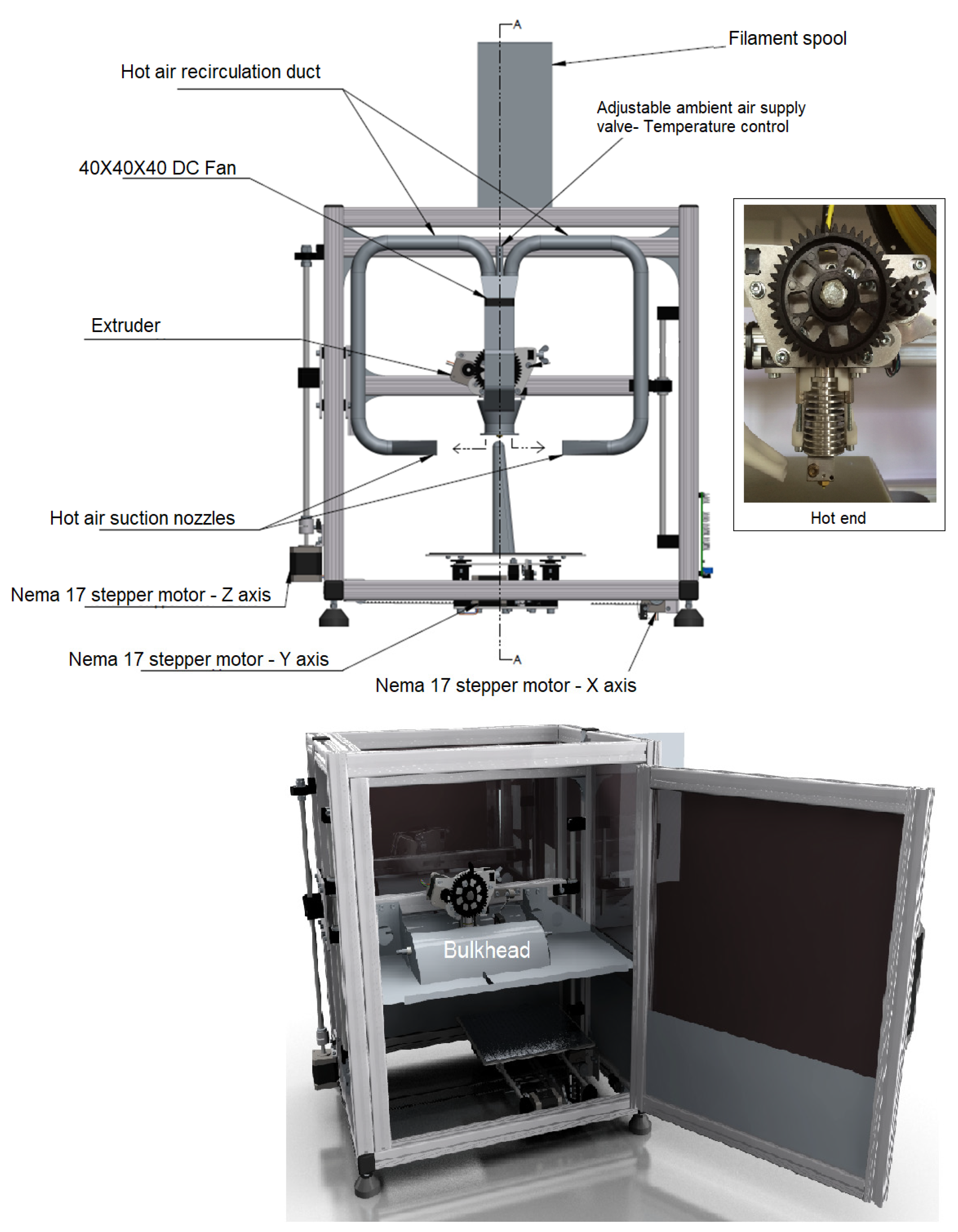
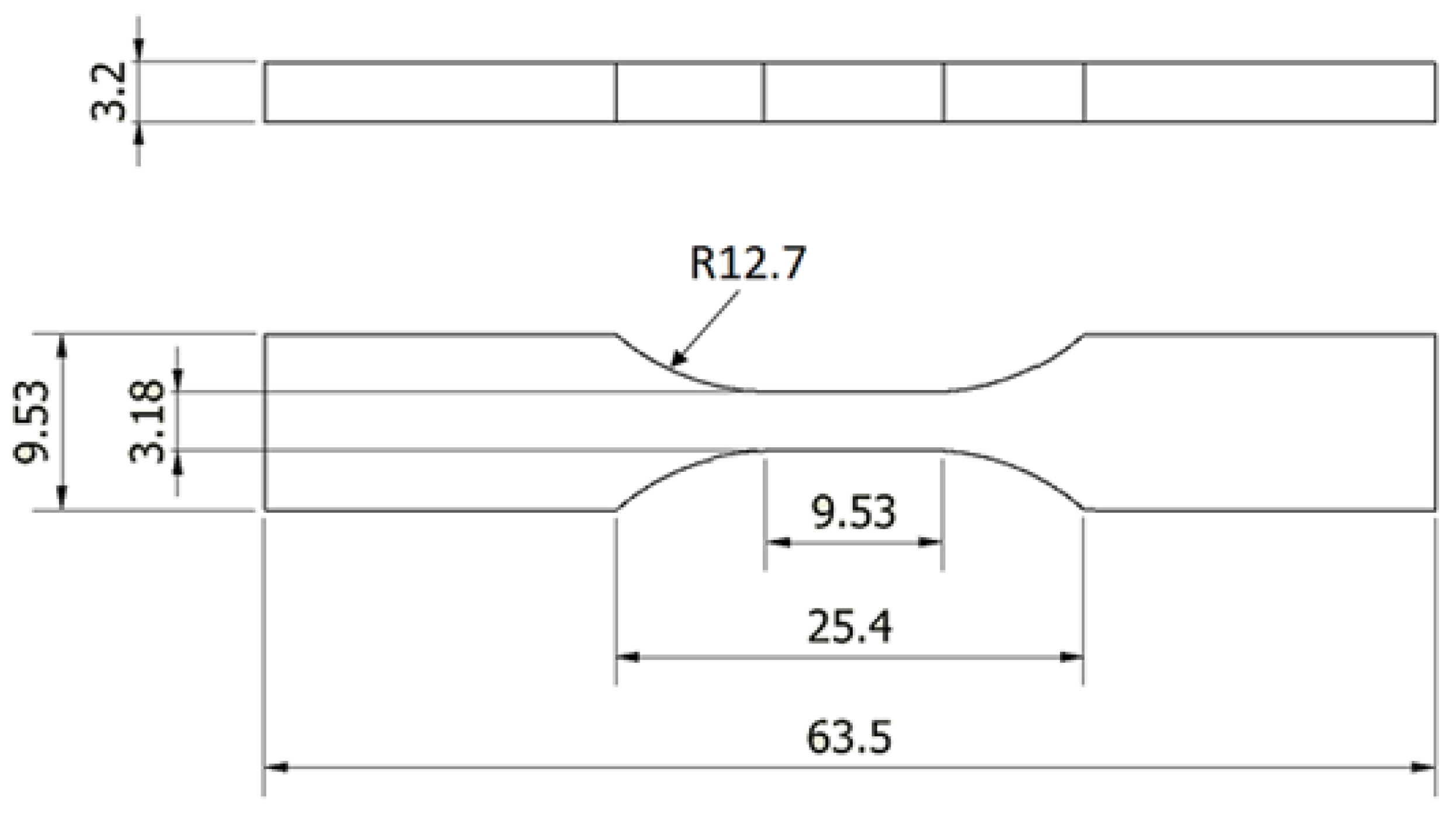
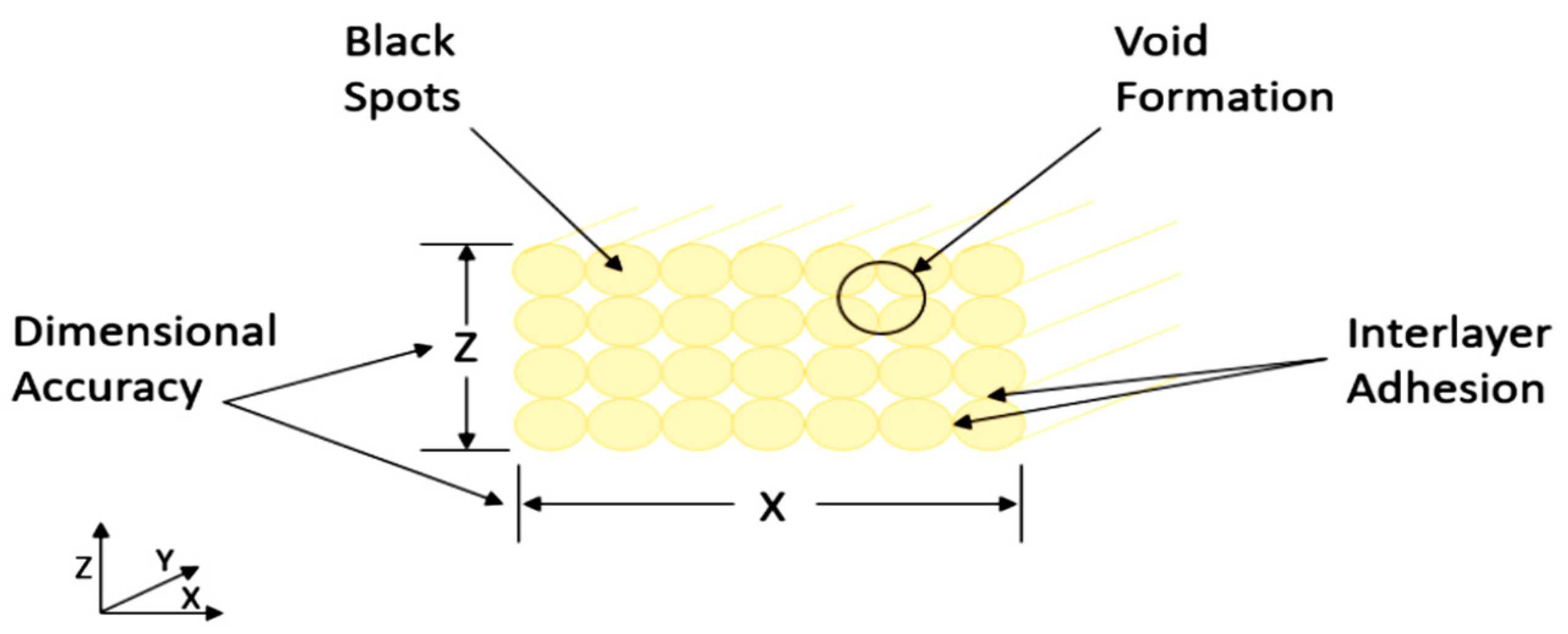
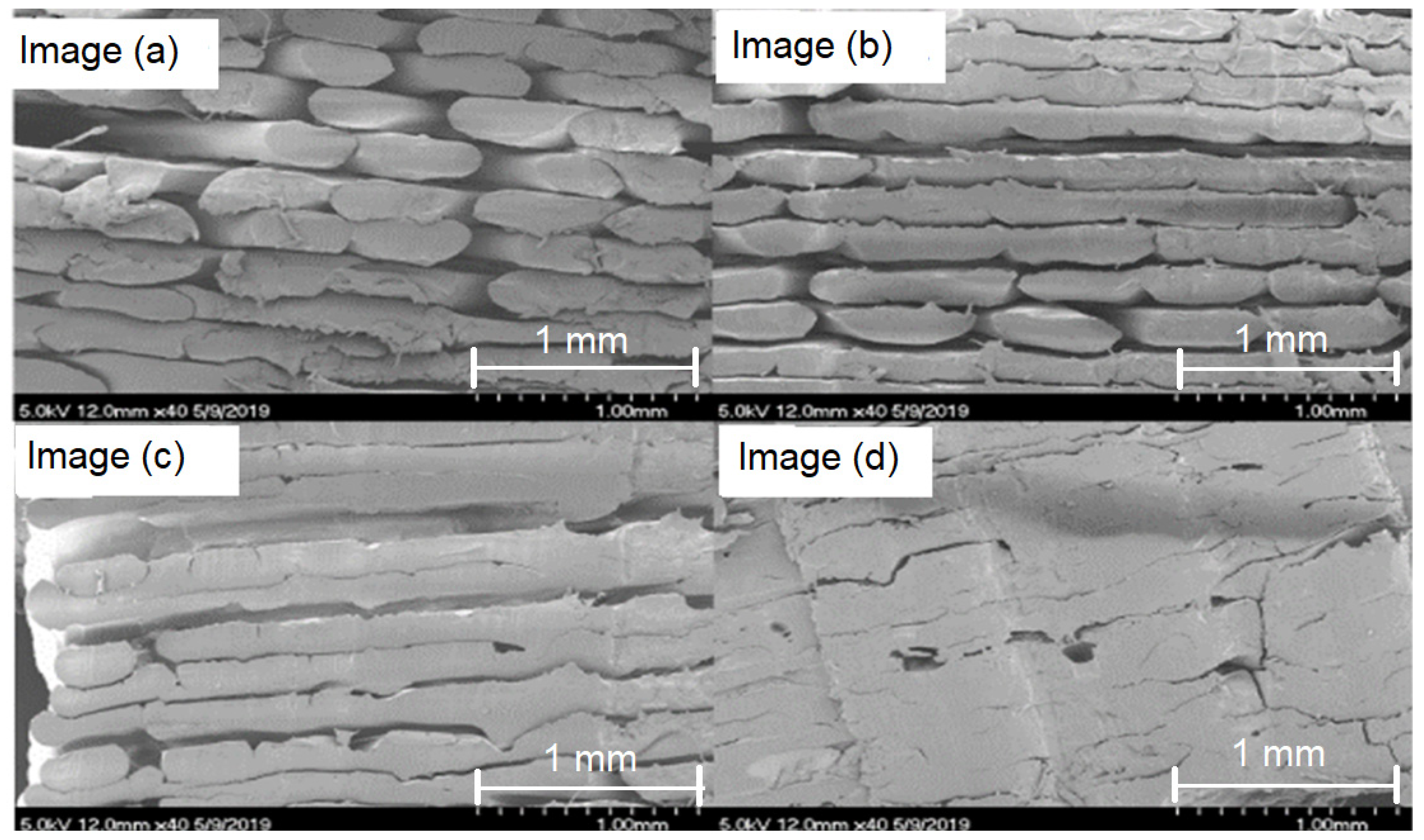
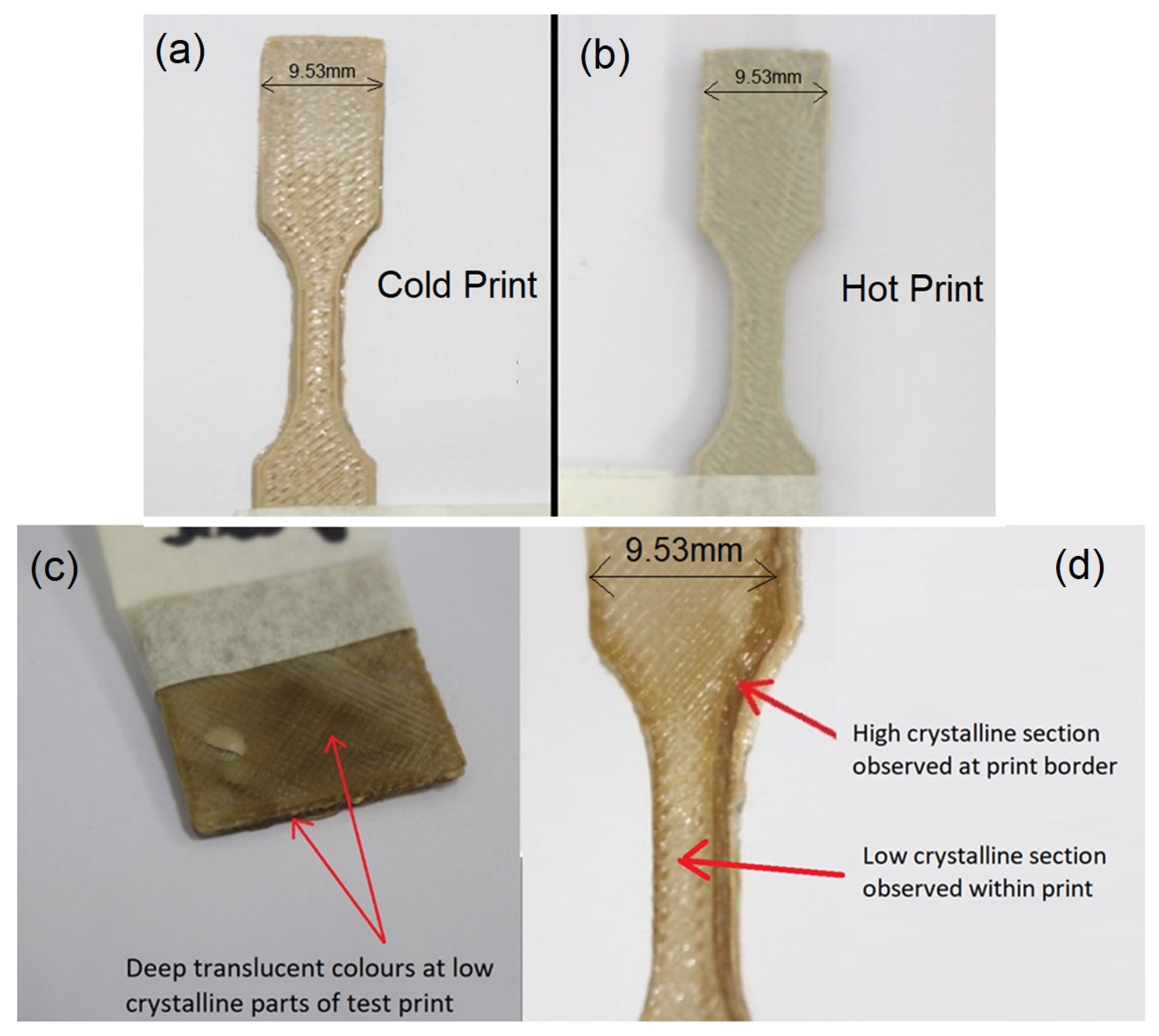
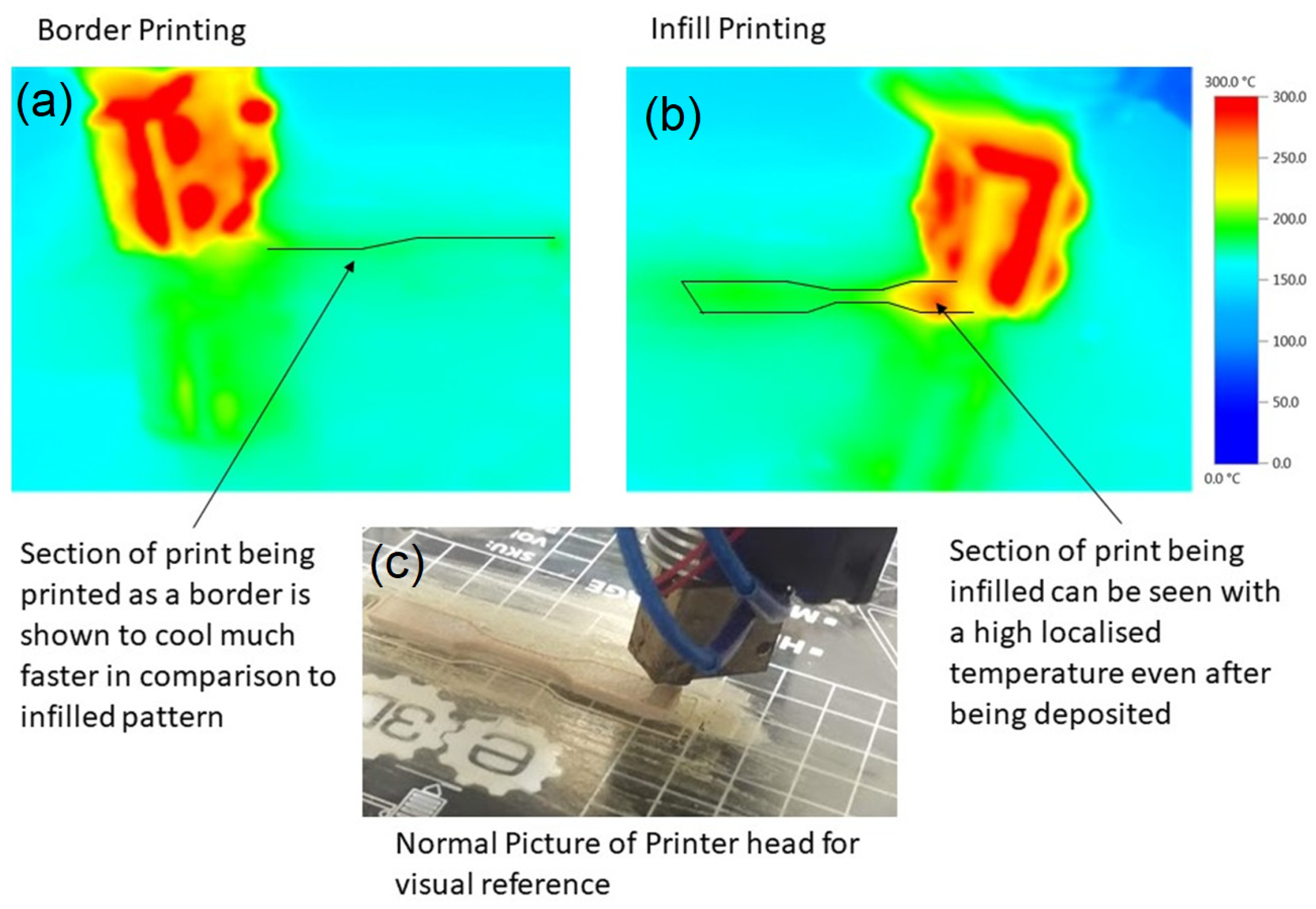

| Concept | Advantages | Disadvantages |
|---|---|---|
| Hot air delivery | Allows precise temperature control of extruded material. High inter-laminar shear strength is possible. Localised high temperature has a low risk of thermal damage to electronics. Can also actively cool the part. | May cause deformation on site due to forced air. Formation of bubbles on the surface is possible and potentially leading to unwanted pores. Air velocity may reduce the dimensional accuracy of print. |
| Dual nozzle design | No wait time when a higher extruding temperature is required (i.e., one extruder will always be at the correct temperature for the next phase of printing while the other extruder is in use). Compact design does not limit the build area. Off-the-shelf component can be used with modifications. Cost effective. | The heat from the “hot” head may be too high and influence the “cold” printing. Unsure of the underlying assumption of there being enough thermal energy in the extruded “hot” material. |
| Ambient temperature control and enclosure | Cost effective. Exact control over ambient conditions. Active cooling can be achieved. | May not provide fine enough control. Isolation of electronics from high ambient temperatures may prove difficult. Can only achieve functional gradient in one axis. |
| Supplementary Heated Plate | Inter-laminar shear strength increased from localised heat at the print site. Easy to control as very few components are required. No moving parts. Localised high temperature has a low risk of thermal damage to electronics. | Cannot affect previous layers, only the top layer. Limited by convection. Can only achieve functional gradient in one axis. |
| Infrared Lamp | Precise control of crystallisation in two axes. Easy control of temperature using a microcontroller. Even distribution of heat is possible. Easy to test and implement (i.e., off-the-shelf components). | No active cooling. Can only achieve functional gradient in one axis. |
| Bed Preparation | Cleaned after each use and a thin layer of Pritt stick applied |
| Adhesion Type | Brim (12 mm) |
| Print Speed | 20 mm/s |
| Outer Perimeter speed | 10 mm/s |
| Inner Perimeter Speed | 10 mm/s |
| Infill Speed | 20 mm/s |
| Infill Pattern | +/−45° |
| Infill | 100% |
| Flow Rate | 75% |
| Extruder Temperature | 390 °C |
| Bed Temperature | 120–140 °C |
| Test 1 | Test 2 | |
|---|---|---|
| Bed temperature (°C) | 120 | 140 |
| Ambient air temperature (°C) | 50 | 140 |
| Radiation temperature (°C) | N/A | 150 |
| Nozzle temperature (°C) | 390 | 390 |
| Sample | Extruder T °C | Bed T °C | Enclosure T (°C) | Bulkhead | Air Flow | Measured UTS (MPa) |
|---|---|---|---|---|---|---|
| 1 | 370 | 120 | 55 | No | 65% | 24.08 |
| 2 | 380 | 125 | 55 | No | 70% | 29.85 |
| 3 | 380 | 125 | 55 | No | 80% | 32.70 |
| 4 | 370 | 120 | 55 | Yes | 80% | 31.97 |
| 5 | 380 | 120 | 55 | Yes | 80% | 36.44 |
| 6 | 390 | 125 | 55 | Yes | 80% | 46.65 |
| H1 | 390 | 135 | 120 | Yes | 80% | 49.87 |
| H2 | 390 | 130 | 120 | Yes | 75% | 43.39 |
| H3 | 390 | 150 | 120 | Yes | 75% | 47.57 |
| H4 | 390 | 125 | 120 | Yes | 75% | 43.67 |
| H5 | 390 | 140 | 120 | Yes | 75% | 47.44 |
| H6 | 390 | 125 | 120 | Yes | 75% | 47.10 |
| H7 | 390 | 125 | 140 | Yes | 75% | 30.07 |
| H8 | 390 | 130 | 140 | Yes | 75% | 47.07 |
| H9 | 390 | 140 | 140 | Yes | 75% | 32.09 |
| H10 | 390 | 145 | 140 | Yes | 75% | 48.40 |
| Sample | Condition | Average |
|---|---|---|
| 1 | Ambient: 45 °C | 49.2 ± 1.2 |
| 2 | Ambient: 120 °C, Bed: 150 °C | 75.2 ± 2.3 |
| 3 | Ambient: 140 °C, Bed 140 °C | 57.4 ± 1.1 |
| 4 | Rod Cut-off | 92.9 ± 2.6 |
| Image | Sample Name | Adjusted Area | Tested UTS (MPa) | Calculated UTS (MPa) | Infrared Temperature (°C) | Bed Temperature (°C) | Print Speed (mm/s) |
|---|---|---|---|---|---|---|---|
| (a) | 3 | 0.39539 | 32.7 | 13.84 | 55 | 125 | 40 |
| (b) | 2 | 0.17495 | 29.85 | 41.69 | 55 | 125 | 60 |
| (c) | 6 | 0.09052 | 46.65 | 63.59 | 55 | 125 | 40 |
| (d) | H1 | 0.04234 | 49.87 | 80.92 | 120 | 135 | 40 |
Disclaimer/Publisher’s Note: The statements, opinions and data contained in all publications are solely those of the individual author(s) and contributor(s) and not of MDPI and/or the editor(s). MDPI and/or the editor(s) disclaim responsibility for any injury to people or property resulting from any ideas, methods, instructions or products referred to in the content. |
© 2023 by the authors. Licensee MDPI, Basel, Switzerland. This article is an open access article distributed under the terms and conditions of the Creative Commons Attribution (CC BY) license (https://creativecommons.org/licenses/by/4.0/).
Share and Cite
McNiffe, E.; Ritter, T.; Higgins, T.; Sam-Daliri, O.; Flanagan, T.; Walls, M.; Ghabezi, P.; Finnegan, W.; Mitchell, S.; Harrison, N.M. Advancements in Functionally Graded Polyether Ether Ketone Components: Design, Manufacturing, and Characterisation Using a Modified 3D Printer. Polymers 2023, 15, 2992. https://doi.org/10.3390/polym15142992
McNiffe E, Ritter T, Higgins T, Sam-Daliri O, Flanagan T, Walls M, Ghabezi P, Finnegan W, Mitchell S, Harrison NM. Advancements in Functionally Graded Polyether Ether Ketone Components: Design, Manufacturing, and Characterisation Using a Modified 3D Printer. Polymers. 2023; 15(14):2992. https://doi.org/10.3390/polym15142992
Chicago/Turabian StyleMcNiffe, Eric, Tobias Ritter, Tom Higgins, Omid Sam-Daliri, Tomas Flanagan, Michael Walls, Pouyan Ghabezi, William Finnegan, Sinéad Mitchell, and Noel M. Harrison. 2023. "Advancements in Functionally Graded Polyether Ether Ketone Components: Design, Manufacturing, and Characterisation Using a Modified 3D Printer" Polymers 15, no. 14: 2992. https://doi.org/10.3390/polym15142992
APA StyleMcNiffe, E., Ritter, T., Higgins, T., Sam-Daliri, O., Flanagan, T., Walls, M., Ghabezi, P., Finnegan, W., Mitchell, S., & Harrison, N. M. (2023). Advancements in Functionally Graded Polyether Ether Ketone Components: Design, Manufacturing, and Characterisation Using a Modified 3D Printer. Polymers, 15(14), 2992. https://doi.org/10.3390/polym15142992








